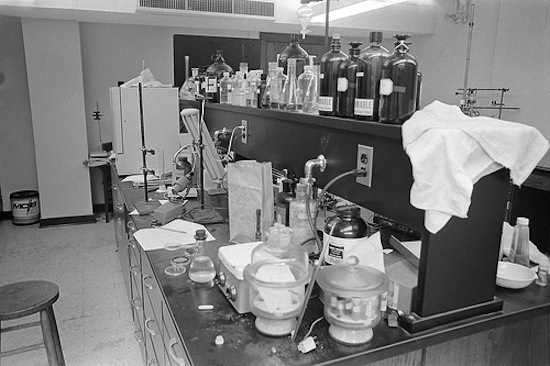The Four Worst Ways the Sequester Will Hit Science Funding
When the so-called sequester — billions upon billions of dollars of cuts to domestic programs, military funding, social services and pretty much any other government program you care to name — was agreed on in 2011 after a spectacularly unproductive round of budget talks, it was meant to be a gun to the head of the American economy. The idea of making blind, thoughtless cuts to popular programs was thought to be so detrimental to the nation’s economy and welfare that the thought of going through it would force Democrats and and Republicans to come together and finally pound out a budget deal that everyone can live with. With the deadline looming and no agreement in sight, though, it seems that we’ve proven no idea is too stupid for the U.S. government. In all likelihood, the sequester will kick in at the end of this week, making cuts in the budgets of agencies like NASA, the NIH, and plenty more American science and technology agencies. How bad is it going to be? Well, here are just a few ways the sequester will kick the teeth right out of science funding.
If the sequester hits — and all indications are that it will kick in at the end of this week on March 1, the Centers for Disease Control, which monitors and works to control outbreaks of disease from food borne illness to STDs, can expect to see budget cuts of between 8-10%. That will mean layoffs, furloughs, and less people tracking everything from the flu to HIV. One of the most noticeable effects of more lax disease tracking could be an increase in outbreaks of diseases like salmonella and E. Coli — the American Public Health Association estimates that CDC belt-tightening would result in up to 150 more outbreaks of food borne illness every year. And with fewer epidemiologists on hand to try to manage and control outbreaks, those more frequent outbreaks could affect more people when they do strike, too.
The National Institutes of Health is looking at 6.4% cuts, which will almost certainly result in labs closing down, though which labs will lose their funding isn’t clear quite yet. What is clear, though, is that lab closures won’t just result in projects and research grinding to a halt. Plenty of scientists with families to feed, mortgages to pay, and more than a few student loans coming due will find themselves out of jobs, as the American Heart Association estimates that more than 20,000 researchers and technicians could be staring down pink slips when the NIH budget gets slashed by $1.6 billion, which looks likely to happen this Friday.
The National Science Foundation, meanwhile, will see it’s ability to make grants for basic research pretty severely hampered. The $538 million in cuts the agency is looking at is about 75% of their 2011 budget for biological research, according to research advocacy group Research America, which included grants for research in agriculture, homeland security, and pretty much everything in between. That also means less money for training programs and scholarships for science students, who can look forward to carrying even more student loans than the current crop of researchers do. Because to be competitive in an evolving global marketplace, America needs to make it more difficult and costly to become a scientist is why.
Our favorite cut — and by favorite, we of course mean “the best example of why this is a terrible idea” — is a fairly tiny cut to NASA’s Commercial Crew Program of just $25 million. That $25 million cut, though, is expected to stall the program for two years, making it a particularly brutal cut in the long term. The CCP incentivizes commercial space travel companies like SpaceX to develop craft that can deliver not just goods, but astronauts to the International Space Station. With the shuttle fleet retired, NASA is left hitching rides from the Russian space agency Roscosmos until a private solution is developed. And since Russia knows it’s our ride, they recently raised the price of a ticket to the ISS from $55.8 million to $62.7 million, and there’s nothing keeping them from raising it again. A delay of two years guarantees that we’ll be paying those ticket prices — whatever they are — for longer than we need to. Harold Bloom has a great rundown of how the sequester will cut funding to American tech companies in favor of writing bigger checks to the Russian government at Scientific American.
So that’s some of the bad news. The worse news? Pretty much all of these cuts are a going to get made, at least for a little while, starting this Friday. Even if we do have an agreement later on, interruptions to funding could still have longstanding effects on America’s scientific standing in the world. Testing on drugs in the research pipeline could be derailed by a funding interruption, while students and scientists in training who lose grants could leave the field never to return, NIH Director Francis Collins told Nature.
And this isn’t even taking into account cuts to programs like Medicare or defense budgets that will hit civilian employees on bases across the country as well men and women in uniform. Things are going to be bad all over, and frankly, there’s no good reason for it other than our elected representatives flat out refusing to work together on one of the most basic functions of government and being more willing to blow a smoking crater in U.S. funding for technology and innovation rather than compromise a single inch. In short, it looks like those clowns in Congress have done it again. What a bunch of clowns.
- Time to get those Kickstarters going, science
- Because science and research should be funded like cookbooks, right? Right!
- Probably not great news for that proposed brain mapping project
Have a tip we should know? tips@themarysue.com
